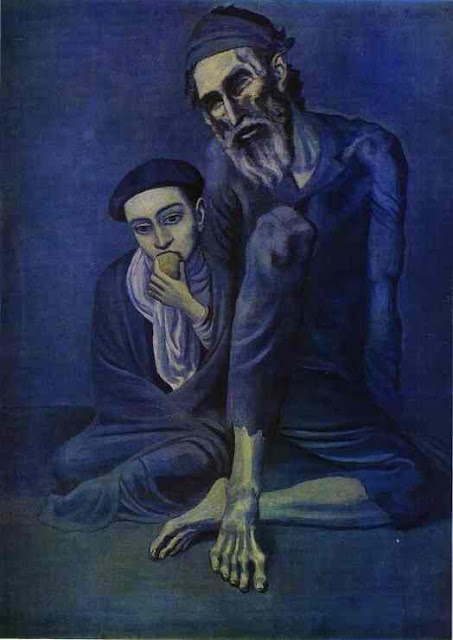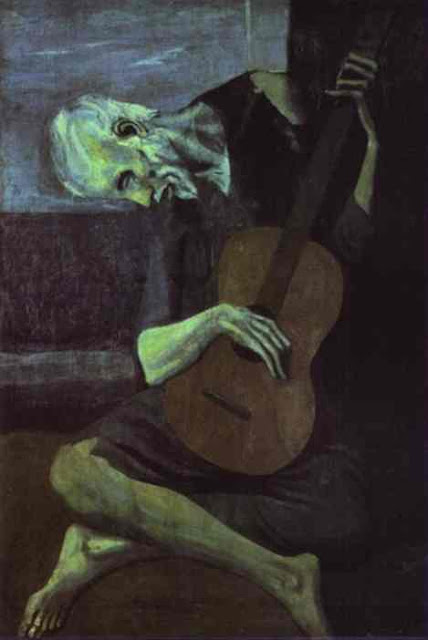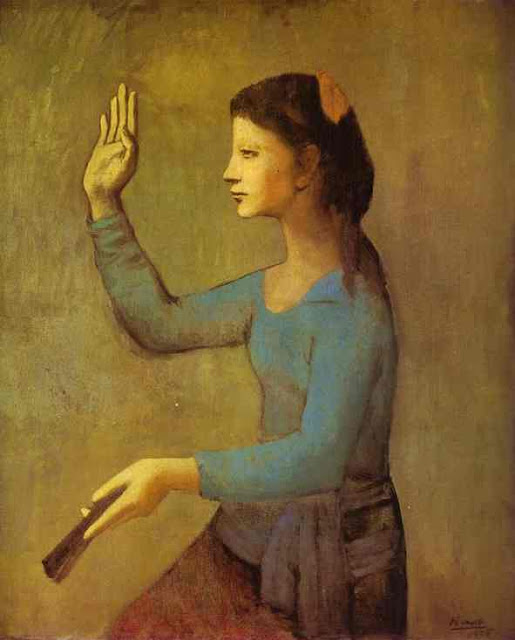
Picasso was a Spanish painter, draughtsman, and sculptor. He is one of the most recognized figures in 20th-century art. He is best known for co-founding the Cubist movement and for the wide variety of styles embodied in his work. Among his most famous works are the proto-Cubist Les Demoiselles d'Avignon (1907) and Guernica (1937), his portrayal of the German bombing of Guernica during the Spanish Civil War.
Picasso demonstrated uncanny artistic talent in his early years, painting in a realistic manner through his childhood and adolescence; during the first decade of the twentieth century his style changed as he experimented with different theories, techniques, and ideas. Picasso creativity manifested itself in numerous mediums, including oil paintings, sculpture, drawing, and architecture. His revolutionary artistic accomplishments brought him universal renown and immense fortunes throughout his life, making him the best-known figure in twentieth century art.

Portrait of the Artist's Mother. 1896. Pastel on Paper.
To say that Pablo Picasso dominated Western art in the 20th century is, by now, the merest commonplace. Before his 50th birthday, the little Spaniard from Malaga had become the very prototype of the modern artist as public figure. No painter before him had had a mass audience in his own lifetime. The total public for Titian in the 16th century or Velazquez in the 17th was probably no more than a few thousand people--though that included most of the crowned heads, nobility and intelligentsia of Europe. Picasso's audience--meaning people who had heard of him and seen his work, at least in reproduction--was in the tens, possibly hundreds, of millions. He and his work were the subjects of unending analysis, gossip, dislike, adoration and rumor.
He was a superstitious, sarcastic man, sometimes rotten to his children, often beastly to his women. He had contempt for women artists. His famous remark about women being "goddesses or doormats" has rendered him odious to feminists, but women tended to walk into both roles open-eyed and eagerly, for his charm was legendary. Whole cultural industries derived from his much mythologized virility. He was the Minotaur in a canvas-and-paper labyrinth of his own construction.
He was also politically lucky. Though to Nazis his work was the epitome of "degenerate art," his fame protected him during the German occupation of Paris, where he lived; and after the war, when artists and writers were thought disgraced by the slightest affiliation with Nazism or fascism, Picasso gave enthusiastic endorsement to Joseph Stalin, a mass murderer on a scale far beyond Hitler's, and scarcely received a word of criticism for it, even in cold war America.
No painter or sculptor, not even Michelangelo, had been as famous as this in his own lifetime. And it is quite possible that none ever will be again, now that the mandate to set forth social meaning, to articulate myth and generate widely memorable images has been so largely transferred from oil paintings and sculpture to other media: photography, movies, television. Though Marcel Duchamp, that cunning old fox of conceptual irony, has certainly had more influence on nominally vanguard art over the past 30 years than Picasso, the Spaniard was the last great beneficiary of the belief that the language of oil paintings and sculpture really mattered to people other than their devotees. And he was the first artist to enjoy the obsessive attention of mass media. He stood at the intersection of these two worlds. If that had not been so, his restless changes of style, his constant pushing of the envelope, would not have created such controversy--and thus such celebrity.
In today's art world, a place without living culture heroes, you can't even imagine such a protean monster arising. His output was vast. This is not a virtue in itself--only a few oil paintings by Vermeer survive, and fewer still by the brothers Van Eyck, but they are as firmly lodged in history as Picasso ever was or will be. Still, Picasso's oeuvre filled the world, and he left permanent marks on every discipline he entered. His work expanded fractally, one image breeding new clusters of others, right up to his death.
Moreover, he was the artist with whom virtually every other artist had to reckon, and there was scarcely a 20th century movement that he didn't inspire, contribute to or--in the case of Cubism, which, in one of art history's great collaborations, he co-invented with Georges Braque--beget. The exception, since Picasso never painted an abstract picture in his life, was abstract art; but even there his handprints lay everywhere--one obvious example being his effect on the early work of American Abstract Expressionist painters, Arshile Gorky, Jackson Pollock and Willem de Kooning, among others.
Much of the story of modern sculpture is bound up with welding and assembling images from sheet metal, rather than modeling in clay, casting in bronze or carving in wood; and this tradition of the open constructed form rather than solid mass arose from one small guitar that Picasso snipped and joined out of tin in 1912. If collage--the gluing of previously unrelated things and images on a flat surface--became a basic mode of modern art, that too was due to Picasso's Cubist collaboration with Braque. He was never a member of the Surrealist group, but in the 1920s and '30s he produced some of the scariest distortions of the human body and the most violently irrational, erotic images of Eros and Thanatos ever committed to canvas. He was not a realist painter/reporter, still less anyone's official muralist, and yet Guernica remains the most powerful political image in modern art, rivaled only by some of the Mexican work of Diego Rivera.
Picasso was regarded as a boy genius, but if he had died before 1906, his 25th year, his mark on 20th century art would have been slight. The so-called Blue and Rose periods, with their wistful etiolated figures of beggars and circus folk, are not, despite their great popularity, much more than pendants to late 19th century Symbolism. It was the experience of modernity that created his modernism, and that happened in Paris. There, mass production and reproduction had come to the forefront of ordinary life: newspapers, printed labels, the overlay of posters on walls--the dizzily intense public life of signs, simultaneous, high-speed and layered. This was the cityscape of Cubism.

Science and Charity. 1897. Oil on canvas

A Spanish Couple in front of an Inn. 1900. Pastel on cardboard.

Leaning Harlequin. 1901. Oil on canvas.

Woman with Chignon. 1901. Oil on canvas

Death of Casagemas. 1901. Oil on wood.

Breakfast of a Blind Man. 1903. Oil on canvas

In 'Lapin Agile' or Harlequin with a Glass.


Acrobat on a Ball. 1905 Oil on canvas. The Pushkin Museum of Fine Art,

The Barefoot Girl. Detail. 1895. Oil on canvas.

Matador Luis Miguel Dominguin. 1897. Pencil on paper

Lola, Picasso's Sister. 1899.

Self-Portrait in Blue Period. 1901. Oil on canvas.


First Communion. 1895/96. Oil on canvas

Portrait of the Art Dealer Pedro Manach. 1901. Oil on canvas

The Absinthe Drinker. 1901. Oil on cardboard.

Woman in a Blue Hat. 1901. Pastel on cardboard

La Vie (Life). 1903. Oil on canvas.

The Tragedy. 1903. Oil on wood.

Woman with a Crow. 1904. Charcoal, pastel and water-color on paper

Tumblers (Mother and Son). 1905.
The Family of Saltimbanques. 1905. Oil on canvas.

The Absinthe Drinker. 1901. Oil on canvas.

L'Absinthe. 1901. Charcoal, pastel, gouache on paper.

Portrait of a Young Woman. 1903. Oil on canvas pasted on cardboard

Portrait of Soler. 1903. Oil on canvas.

Boy with a Dog. 1905. Pastel and gouache on cardboard

Old Beggar with a Boy.1903. Oil on canvas

Two Brothers. 1905. Oil on canvas.

The Old Guitarist. 1903. Oil on panel

Woman with a Cigarette. 1901. Oil on canvas.

L'ascete. 1903. Oil on canvas

Acrobat and Young Harlequin. 1905. Oil on canvas

Young Girl with a Goat. 1906. Oil on canvas


Le Gourmet. 1901. Oil on canvas.

Juggler with Still-Life. 1905. Gouache on cardboard

Lady with a Fan. 1905. Oil on canvas.

L'Absinthe. 1901. Charcoal, pastel, gouache on paper.
Source URL: https://amywinehousedff.blogspot.com/2011/08/pablo-ruiz-picasso-1881-1973.htmlVisit Amy Winehouse for Daily Updated Hairstyles Collection











No comments:
Post a Comment